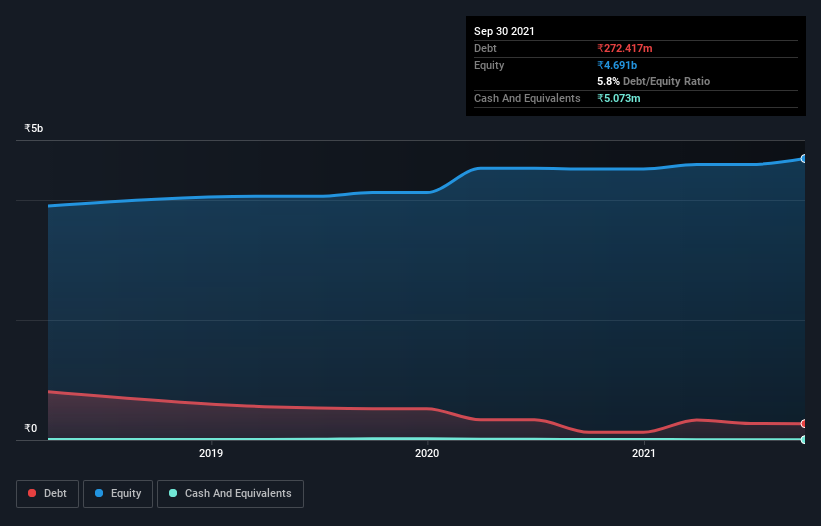We Think Trejhara Solutions (NSE:TREJHARA) Is Taking Some Risk With Its Debt
Howard Marks put it nicely when he said that, rather than worrying about share price volatility, 'The possibility of permanent loss is the risk I worry about... and every practical investor I know worries about.' It's only natural to consider a company's balance sheet when you examine how risky it is, since debt is often involved when a business collapses. As with many other companies Trejhara Solutions Limited (NSE:TREJHARA) makes use of debt. But should shareholders be worried about its use of debt?
When Is Debt Dangerous?
Debt and other liabilities become risky for a business when it cannot easily fulfill those obligations, either with free cash flow or by raising capital at an attractive price. If things get really bad, the lenders can take control of the business. However, a more common (but still painful) scenario is that it has to raise new equity capital at a low price, thus permanently diluting shareholders. By replacing dilution, though, debt can be an extremely good tool for businesses that need capital to invest in growth at high rates of return. When we think about a company's use of debt, we first look at cash and debt together.
View our latest analysis for Trejhara Solutions
What Is Trejhara Solutions's Debt?
As you can see below, at the end of September 2021, Trejhara Solutions had ₹272.4m of debt, up from ₹128.4m a year ago. Click the image for more detail. Net debt is about the same, since the it doesn't have much cash.

A Look At Trejhara Solutions' Liabilities
Zooming in on the latest balance sheet data, we can see that Trejhara Solutions had liabilities of ₹982.5m due within 12 months and liabilities of ₹236.0m due beyond that. On the other hand, it had cash of ₹5.07m and ₹205.0m worth of receivables due within a year. So it has liabilities totalling ₹1.01b more than its cash and near-term receivables, combined.
Given this deficit is actually higher than the company's market capitalization of ₹804.7m, we think shareholders really should watch Trejhara Solutions's debt levels, like a parent watching their child ride a bike for the first time. Hypothetically, extremely heavy dilution would be required if the company were forced to pay down its liabilities by raising capital at the current share price.
In order to size up a company's debt relative to its earnings, we calculate its net debt divided by its earnings before interest, tax, depreciation, and amortization (EBITDA) and its earnings before interest and tax (EBIT) divided by its interest expense (its interest cover). This way, we consider both the absolute quantum of the debt, as well as the interest rates paid on it.
We'd say that Trejhara Solutions's moderate net debt to EBITDA ratio ( being 1.8), indicates prudence when it comes to debt. And its commanding EBIT of 30.8 times its interest expense, implies the debt load is as light as a peacock feather. Importantly, Trejhara Solutions grew its EBIT by 58% over the last twelve months, and that growth will make it easier to handle its debt. The balance sheet is clearly the area to focus on when you are analysing debt. But you can't view debt in total isolation; since Trejhara Solutions will need earnings to service that debt. So if you're keen to discover more about its earnings, it might be worth checking out this graph of its long term earnings trend.
Finally, while the tax-man may adore accounting profits, lenders only accept cold hard cash. So we always check how much of that EBIT is translated into free cash flow. Over the last three years, Trejhara Solutions reported free cash flow worth 18% of its EBIT, which is really quite low. For us, cash conversion that low sparks a little paranoia about is ability to extinguish debt.
Our View
We feel some trepidation about Trejhara Solutions's difficulty level of total liabilities, but we've got positives to focus on, too. To wit both its interest cover and EBIT growth rate were encouraging signs. We think that Trejhara Solutions's debt does make it a bit risky, after considering the aforementioned data points together. That's not necessarily a bad thing, since leverage can boost returns on equity, but it is something to be aware of. When analysing debt levels, the balance sheet is the obvious place to start. However, not all investment risk resides within the balance sheet - far from it. We've identified 1 warning sign with Trejhara Solutions , and understanding them should be part of your investment process.
When all is said and done, sometimes its easier to focus on companies that don't even need debt. Readers can access a list of growth stocks with zero net debt 100% free, right now.
Valuation is complex, but we're here to simplify it.
Discover if Trejhara Solutions might be undervalued or overvalued with our detailed analysis, featuring fair value estimates, potential risks, dividends, insider trades, and its financial condition.
Access Free AnalysisThis article by Simply Wall St is general in nature. We provide commentary based on historical data and analyst forecasts only using an unbiased methodology and our articles are not intended to be financial advice. It does not constitute a recommendation to buy or sell any stock, and does not take account of your objectives, or your financial situation. We aim to bring you long-term focused analysis driven by fundamental data. Note that our analysis may not factor in the latest price-sensitive company announcements or qualitative material. Simply Wall St has no position in any stocks mentioned.
Have feedback on this article? Concerned about the content? Get in touch with us directly. Alternatively, email editorial-team (at) simplywallst.com.
About NSEI:TREJHARA
Trejhara Solutions
Provides technology products and solutions in the Asia Pacific and internationally.
Flawless balance sheet with slight risk.
Market Insights
Community Narratives



